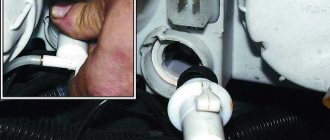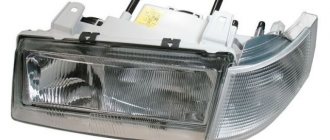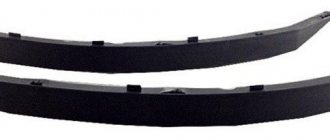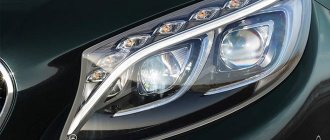The Lada Priora car has different options for tuning headlights. This could be: replacing the substrate with a different color, due to which the Priora headlights will acquire a new tinted color. Installation of lenses. Painting or decorating with eyelashes. Tuning headlights on a Priora is not just decoration. Good optics will illuminate the road so that at night visibility conditions will be much better. People complain about the Lada Priora family that the standard one is “dim.” Owners take care of the optics so that the front headlights shine well, and the rear ones look beautiful, but are safe - after all, these are brake lights.
Tuning headlights on a Priora with your own hands is not a fairy tale. You can change the optics on your car yourself without contacting a service center. For example, installed LEDs in the angel eyes style will highlight the elements of the car, and this operation is no more difficult than assembling a construction set.
A good solution for the Priora is to install a brighter lamp and be sure to adjust it. Previously, it was “customary” to completely change the headlight unit, which changed the appearance of the car very much. Tuning the front and rear lights on a Priora is not so complicated, but it will create its own highlight for your favorite car.
You should know moderation in everything - if the desire is too strong, car owners neglect the technical inspection standards, and therefore the lighting fixtures either become dimmer or become so bright that they blind other road users, and this is, at the very least, impolite. Read the article to the end and find out all the details of this topic!
Cilia
Tuning Priora headlights, for many, ends precisely at the “eyelashes”. These are ordinary covers that follow the shape of the top of the headlight and are painted in body color. They are sold ready-made in auto parts stores, but eyelashes can be made. They can be made from a piece of vinyl film, the shape of which will have to be changed in order to be applied to the headlight - this is done with a soap solution (in the same way as with applying tint). The trims from the store are attached to the body either with sealant or double-sided tape. Remember that eyelashes limit the height of the illuminated space. In addition to them, there are other worthy ideas for tuning the Lada Priora.
There are no limits to perfection
People with indefatigable creative imagination modify the appearance of their cars beyond recognition. In the case of the Lada Priora, this is also due to the fact that its features do not correspond to modern fashion trends in the “sportiness” of the car’s appearance.
You can improve the appearance of the Priora by performing a small and accessible optics tuning in different ways:
- change the shape of the headlight using “cilia”;
- install LED backlighting - “angel eyes”;
- paint the headlight reflector black;
- tint headlight glass.
Return to contents
Installing lensed headlights
Installing lenses will change the illumination - after the modification, there will be no standard optics left inside the unit. First of all, a reflector will appear that will redirect the light rays forward into the space in front of the car. Instead of standard light bulbs, optics with lenses are installed, which creates a spectacular glow.
This option is considered the most expensive, and the effect will be noticeable. Separately, you can change the color of the substrates if you can’t spend money on optics.
How to install angel eyes
Angel eyes on the Priora are LEDs that are installed inside the front unit, along the perimeter of the lenses and in the rear light. To do this you need to purchase:
- Electric wire of moon-white color. Type SH; diameter 2.6 mm;
- Receiver (Operating voltage – 12 Volts).
After everything is ready, you can begin active actions:
- Raise the hood, remove the battery (this will make it easier to work).
- Dismantle the block, remove the substrates.
- First secure the wires in place with tape (lightly) or clothespins - this is done to fix their position. Then fix them with epoxy resin.
- Wait for the resin to dry, secure the substrates and seal all the gaps with sealant so that the glass does not fog up. We carry out the installation.
Painting headlights
Tuning the front and rear lights on a Priora is not limited to increasing the aperture ratio. They can be tinted. But this does not mean that you need to paint the glass - the light will simply become cloudy. The tinting effect is obtained due to a change in the color of the substrate. This is done using high temperature paint.
Read also: Headlights for VAZ 2107
This is done in the following order:
- The entire block is removed and the backing is removed;
- Wipe off the chrome from the substrate (zero polish will help). Cover the substrate with two or three layers of primer and wait about an hour;
- Apply 4-5 layers of paint over the primer, wait for each layer to dry;
- Assemble the block lights, close all the cracks to prevent fogging;
- After painting, all that remains is to adjust them. The main thing is that the light is not too dim and does not cause inconvenience when driving.
Adjustment after any modification of the optics is performed as follows:
- Place the car at a distance of 5 m from a flat wall (for example, opposite the garage);
- Set the adjusting screws under the hood to “0”. Put a person of similar height behind the wheel;
- The headlights are adjusted one by one; while one is being adjusted, the second one is closed;
- The clear edge of the light should be 10 mm below the top edge of the headlight.
Adjustment is not a useless requirement of technical inspection standards. This must be done for comfortable driving at night - you won’t need to peer and look for obstacles on the road, they will be illuminated if adjusted correctly.
Headlight tinting
You can tint the headlights on the Priora yourself using the following means:
- black tint film;
- black spray paint. Unlike film, it is applied in several layers.
In some cases, the headlights on a Priora are tinted not black, but in a different color that matches the shade of the body. You need to understand that applying tinting will worsen the visibility of the road surface at night. Therefore, in order to avoid accidents, such modernization is most often carried out on car lights.
To install the tint yourself, cut out the required section of the film. The glass (reflector) of the lantern is moistened with a soap solution or water, and the film is applied there by heating it with a hairdryer. If paint is used, you will need to remove the glass and apply it to the inside of the lantern. Possible incomplete painting (pasting), but application of a pattern.
What is the best way to make black headlights, use tinting varnish or vinyl film?
We can say that film tinting of headlights has the advantage of quick installation and dismantling. Using this tinting method you will need: a technical hair dryer, a plastic scraper, a water sprayer, rags, a stationery knife and vinyl film (for example, Oracle (oracal 8300)).
Tinting the rear lights of Lada Priora without removing
First you need to clean the headlight glass from dirt. Then we spray water on the glass and apply a tint film. Using a hairdryer, heat the film into the desired shape. Smooth the film with a scraper, driving out the water. We cut the film along the contour of the headlight. We wait until it dries. The process is well shown in the video:
Example, tinted rear lights with 15% film:
Vinyl film oracl 8300, 073 color:
Tinted rear optics of Priora with headlight removal
In this case, it will be more convenient to work, and there is less chance of spoiling something. First you need to remove the Priora taillights, then the process is similar:
Partial tinting of VAZ 2170 headlights
- We clean the headlight glass with window cleaning liquid so that there are no streaks or greasy stains.
- Cut out a rectangle 25cm wide from the film.
- We wet the headlight glass with soapy water, peel off the protective layer on the film, and apply it to the middle area of the headlight.
- We expel air and water from the middle to the ends using a spatula. We pass with a cloth around the perimeter.
- We cut off unnecessary parts of the film along the rim line using a stationery knife.
- We remove the remaining water, heat it with a regular or technical hair dryer, smoothing the film with a dry cloth.
In the same way, you can tint the other part of the headlight, thereby making the tuning unique.
We would like to remind you that the darker the tinting of the rear headlights, the worse the brightness of the light will be, which may raise additional questions when undergoing maintenance, or provoke an accident.
By the way, do you know how to tune the rear lights?
A car enthusiast must devote a lot of time to maintaining his car in a condition that meets the standards. Changes to the car may cause an accident. The degree of emergency situations on the road will increase when tuning the car. It may reduce your visibility. Therefore, the law provides for a fine for tinting headlights with film. However, if the lighting device complies with the standards and the light transmission is good, the driver cannot be punished.
According to GOST, dimming headlights, using tinting varnish or film stickers on headlights, does not take away more than 15 percent of the light. This mainly applies to headlights.
Installation of LED DRLs
LEDs for replacing daytime running light bulbs must comply with GOST. They provide excellent light during daylight hours, and if connected correctly, light up when the ignition is turned on.
The connection is made through a five-pin relay; plastic corrugations can be used to insulate the wires. Each LED block will have a black and a red wire coming from it. It is advisable to connect the black one to the windshield wiper fuse F11 (20), and the red one to the left side light fuse F14(5).
The use of LED DRLs instead of factory ones after the first week will change the Priora owner’s view of his own car. Such a small part can cost about 500 rubles for two lights, but its appearance on the road will be noticeable to everyone.
Tinting Priora windows is done not only to give the car a respectable appearance. This operation also has purely practical significance. Firstly, it limits the curious view of what is happening in the cabin, which, by the way, irritates the traffic police, and, secondly, it slightly weakens the effect of direct sunlight, allowing you to maintain at least a little coolness in the summer. Well, the stylishness of the car is a separate topic. And here the question arises about tinting the remaining windows of the car. In particular, the headlights.
How to tint headlights
There are two ways to carry out this operation on Priora. Moreover, using completely different materials.
- Pasting with film.
- Applying paint.
Each of them has its own advantages and disadvantages, which the owner of the Priora should find out about in advance. In order to correctly navigate the choice of method and material for tinting.
First of all, the disadvantage of film tinting is that the headlight glass gets quite hot, and the tinting often comes off. What forces you to carry out this operation again. In addition, the film loses its quality due to temperature.
In this regard, painting for Priora is a much more durable option. However, when tinting with varnish, it is very difficult to choose the correct layer thickness. And this radically affects the ability of tinted glass to transmit light. In addition, the varnish is applied to the inside of the glass. At the slightest inaccuracy in the painting process, under the influence of temperature, it swells with bubbles and peels off, which also negatively affects the lighting. In addition, the paint does not withstand high pressure washing. It begins to wash off, so there is no way to use it on the Priora from the outside, only from the inside.
Tinting of headlights and taillights with a special film
To carry out this operation on Priora, the following things will be required.
- Tinting film.
- Scissors.
- Soap solution.
- Liquid (alcohol) for degreasing glass.
- Construction or household hair dryer.
- Locksmith set of keys.
- Screwdrivers, figured and regular.
First of all, to tint the Priora's headlights, you will have to remove the bumper. It is impossible to remove the headlights on a Priora without this procedure.
To remove the bumper, you need to unscrew its fasteners. This is not a very difficult task, however, it requires accuracy. Because otherwise there is a risk of scratching the bumper. It is secured with 16 bolts. Under a figured screwdriver and a 10 key. 12 at the bottom and 4 at the top. At the bottom it is secured with three screws along the cut of the arch of each wheel, and three bolts along the bottom edge to the body. By removing this fastener, you can easily remove the bumper.
After removing the bumper, all that remains is to unscrew the 2 bolts securing the protection on top of the headlight, and the fasteners of the headlight itself. Disconnect the plug with the wires and take the “spotlight” out.
Now directly apply the tint to the Priora headlights. First, wipe the glass with a degreasing liquid until completely clean. Measure a piece of film exactly to size. Apply soapy water to the surface of the glass. Apply the film and smooth it thoroughly. Trim the excess exactly to the shape. After this, warm it up with a hairdryer for at least an hour. But it is better within 4-6 hours. Reassemble everything in reverse order and let it sit for a few more hours.
Read also: Error p2238 Toyota Prado 120
Painting glass with tinted varnish
The convenience of this method is that the material is sold ready for application. In spray cans. The bumper and headlight are removed exactly as described above. But only with the “painting” option, the tint is applied to the inside of the glass. Therefore, the headlight itself will have to be disassembled. This is where you will need a hairdryer.
The glass of the light fixture is secured with sealant and to remove it, the joints must be properly heated. Until the adhesive reaches the required consistency. After this, the glass can be removed. Now degrease the glass from the inside, cover the edge to ensure it fits to prevent paint from getting in, and you can paint it. This material is usually applied in 2-3 layers. But here you need to be very careful not to completely obscure the lantern (headlight).
After applying the tint, you also need to dry the glass with a hairdryer, then assemble the unit and install it in place.
Sometimes, some car enthusiasts paint not the glass, but the reflective element itself. This is absolutely not worth doing. After such “treatment” it is guaranteed to fail, and replacing it is quite a tedious task.
In the proposed video, Priora headlights are tinted with a special film.
Hello, dear friends! Today we will talk to you about such a topic as tinting rear lights. To be more precise, I will tell you what methods can be used to perform such a procedure, how legal it is and whether you should be afraid of fines.
In fact, this procedure did not become popular in 2017 and certainly not in 2021. But now I’m increasingly hearing questions about whether it’s legal to do it yourself.
Some argue that tinting is completely prohibited. And those who try to tint the optics with red film will immediately receive a huge fine or even lose their license for a whole year.
It is necessary to dispel some common myths and tell everything as it is. Let's talk both about the potential fine and about ways that allow you to tint the rear lights of your own car with your own hands without unnecessary problems.
And eyes like an angel
To tune the optics in the “angel eyes” style, you will need to not only dismantle the headlight, but also disassemble it to get to the very “essence”. Therefore, you can combine two methods of improvement at once - install “eyes” and tint the reflector (mask, blender) black.
Materials and tools:
- masking tape - to preserve the glass during dismantling;
- screwdriver with T20 tip - for removing the blender;
- technical hair dryer;
- black spray paint;
- plastic tube;
- LEDs with suitable resistors;
- aluminum tape;
- glue;
- hacksaw;
- sealant.
Step 1. Remove the headlight according to the instructions for the car. Cover the headlight glass with masking tape so as not to damage the surface during further dismantling.
Step 2. Bend the brackets (on Bosch headlights) or plastic sides (headlights made by Kirzhach). Using a hair dryer, remove the sealant and remove the glass.
Step 3: Remove the chrome reflectors using a Phillips screwdriver. Cover the turn signal lens with tape.
Step 4. Sand the chrome surface and treat it with 2 layers of aerosol primer for plastic. Dry for an hour.
Step 5: Apply several coats of black spray paint, allowing each layer to dry. After the last layer has dried, remove the tape from the turn signal lens.
If tuning the optics is limited only to tinting the reflector, the headlight can be assembled, not forgetting to apply a layer of sealant to the junction of the glass and the housing.
You can continue tuning and install “angel eyes”. The easiest way is to use a ready-made set of “angel eyes” made from gas-discharge tubes.
But “our people don’t take a taxi to the bakery” - let’s try to create a unique work with our own hands.
| Step |
Description of actions
Optics decorated with LEDs
Apply aluminum tape to the surface of the rings that will face the headlight body so that the light from the tube does not reflect in the reflective layer of the lamps. Wrap the ends of the tubes completely with tape.
Secure the rings to the blender using instant glue. Assemble and install the headlight, connect the “eye” wires to the side lighting.
Let's turn to GOST
You probably know that there are rules and laws regarding tinting car windows. Just recently I talked about removable tinting, and we also discussed the issue of curtains for a car. I advise you to refresh your memory and read the materials again.
In addition, I would suggest that you familiarize yourself with removable tinting on a rigid base, the link to which will be here, and removable silicone tinting with a link here.
Now let's talk specifically about the rear lights. There are no requirements for their tinting. There are only regulations for the operation of automotive lighting equipment. Regarding the rear optics, it states that only yellow, red and orange light can be used. All others are prohibited.
There is one correction here. To illuminate the reversing lamp in the Russian Federation, only white light is used, as well as to illuminate the license plate.
These are the only official rules regarding this matter. That’s why you need to rely on them when you decide to tint the rear optics. If any color other than those listed is used, when recording this fact, law enforcement officers will classify this as an offense. Therefore, you will be issued a fine.
Potential penalties
If there is tinting on the rear optics that does not correspond to the characteristics prescribed in the Code of Administrative Offenses, then the driver of the vehicle will be fined.
Only here there are important nuances. The thing is that in the current legislation there are no specific clauses that relate specifically to rear optics. Just don’t think that it’s now legal to tint your headlights any color you like.
Here, traffic police officers will rely on Article 12.5 Part 1 of the Administrative Code. That is, they will charge you with a violation due to vehicle malfunctions in accordance with the requirements for permitting a vehicle to operate. If your taillights are in poor condition, get ready to receive a fine of 500 rubles.
Drivers note that traffic police officers rarely issue fines for such violations. And if you tint the optics without changing the color of the instruments, then there will be no problems at all.
Even though there is practically no threat of a fine in this situation, it is still necessary to remind you about the methods of paying fines. A link to interesting and useful material about this will be here.
Read also: Shell Helix Ultra 5w40 how to spot a fake
Tinting methods
I quite often see how the rear optics are tinted on domestic cars like Lada Priora, Grant, Vesta, Kalina, more classic VAZ 2114, 2110, etc.
But tinting also looks good on foreign cars such as Mazda 3, Hyundai Solaris, Ford Focus. The question here is rather what material to use and how well the work itself is done.
Since we have already decided whether such tinting is allowed, we can move on to the topic of creating such a tuning element. It is definitely not prohibited, although it is carried out within certain restrictions. St. Petersburg, Moscow and many other cities offer a wide list of tuning studios where you can tint your optics.
Before you make a decision, think about how exactly you will do it. Be sure to look at the photos of the finished options and evaluate the proposed methods. There are three methods in total.
- Varnish. The use of varnish is quite common, although it is not considered ideal. It has its nuances and shortcomings;
- Liquid rubber. A relatively new method, characterized by an exquisite visual effect after application. In my personal ranking, liquid rubber takes second place;
- Special films. Everyone recognizes that film tinting is the most profitable, spectacular and effective. Even if the price is slightly higher compared to varnish.
Now we will consider each method separately to bring some clarity.
Until films became widespread, everyone used varnish. But even in our time there are car enthusiasts who prefer this option.
To tint the taillights, you need to buy a can of special varnish. It is applied in several layers after the previous one has dried. The number of layers determines the degree of darkening of the headlights.
If you want to do this with a spray can yourself, you will need:
- thoroughly clean the surface to be treated;
- cover the paint layer of the car around the lights with paper or polyethylene;
- or dismantle the optics completely so that the paint does not get on other parts of the body;
- apply the first layer and wait until completely dry;
- apply a second layer and also wait until the paint dries;
- Carry out a similar procedure on both sides of the car until the desired darkening is achieved.
Remember that it will be impossible to restore the lights after applying varnish. You'll have to buy new optics.
Liquid rubber
A relatively new method based on the use of liquid rubber. Moreover, in Russia, PlastiDip products are the most popular.
Liquid rubber is sold in the form of spray cans or in cans, the contents of which are poured into the spray gun. To tint the headlights, special transparent rubber is used.
When a layer of material is applied, the optics acquire a matte and slightly darkened structure. Rubber can be used to quickly and easily improve the appearance of your lights. The material dries quickly and is removed from the surface.
Film
Objectively, the best material for tuning taillights is special high-quality films. They are made specifically for rear lights. Additionally, they have a damage protection function.
Its advantages include:
- adequate price;
- high quality;
- long service life;
- ease of application;
- protecting the headlight housing from damage;
- possibility of dismantling;
- good light transmittance;
- minimum complaints from traffic police officers;
- wide choose.
But it is still important to understand that tinting in the case of rear optics is used purely as a tuning element. It has no significant practical side.
Now briefly about the application procedure itself.
If you decide to tint the taillights with film yourself, you can do it something like this:
- headlights are thoroughly washed;
- a film is applied and the required piece is cut out with a small margin;
- the headlight is sprayed with soapy water from a spray bottle;
- the protective layer is removed from the film and placed on the surface of the optics, avoiding folds;
- using a squeegee and heating the film with a regular household hairdryer, it spreads over the surface;
- Finally, the excess is trimmed off.
Nothing complicated. But the effect amazes many. And no one needs to pay for the work if you are more careful and attentive.
Share your opinion regarding tinting the rear lights of cars and your experience in such matters. It will be interesting to listen to you. Thank you all for your attention! Subscribe, leave comments and ask relevant questions!
( 5 ratings, average: 4.80 out of 5)
Did you like the article?
Subscribe to updates and receive articles by email!
We guarantee: no spam, only new articles once a week!
«>
Varnish against film
I noticed that these things are mostly done by young drivers. Moreover, most of them have domestic cars, such as VAZ 2107, 2109, 2114, Vesta, Priora, etc. Even in 2017, I myself thought about sticking a film on my crossover, but that’s why I decided against it. I just inserted new optics. Looks great.
Some are tinted with varnish, others use special films. In 2021, the choice of materials is huge. But still, if you decide to take such a step, I advise you to use film. The varnish is more difficult to apply, it is almost impossible to remove it from the surface of the glass, and there will be much more hassle with the varnish if you are forced to remove the tint. Sometimes it’s easier to just install a new set of headlights.
But the film is based on vinyl. It additionally protects the surface of the optics from mechanical shocks and minor damage. Plus the film is quickly and easily removed.
When choosing a material, consider several key nuances:
- from a practical and convenient point of view, film is better than varnish;
- Optics can be tinted using matte and glossy types of material;
- the tone used should not absorb more than 15% of the standard brightness of your headlights;
- if you break this rule, you will be fined;
- if the tone is provided from the factory, you are not required to remove it or pay a fine;
- If you tint yourself incorrectly, you will be fined;
- Sometimes they may require you to remove the film or replace the optics because they do not meet the standards.
Just like that. Therefore, carefully weigh your decision and think a hundred times before gluing the first film you come across, or starting to apply the first layer of varnish.











